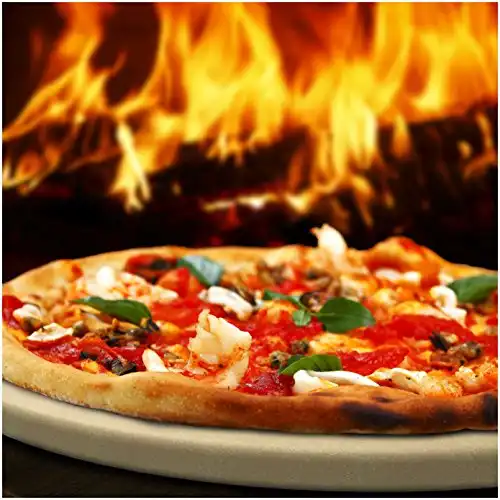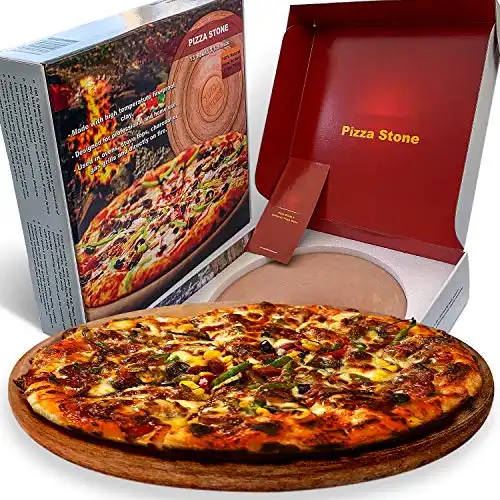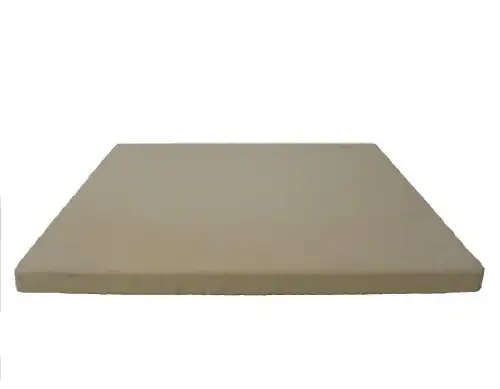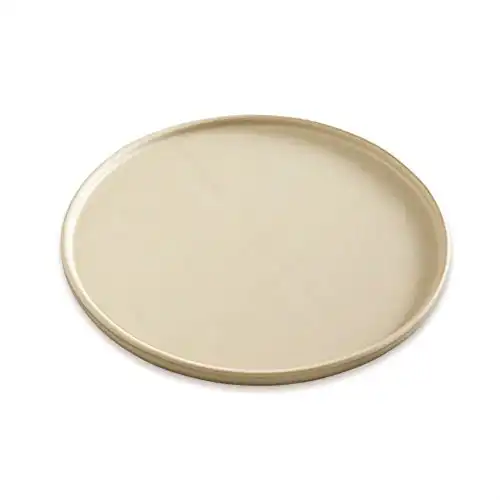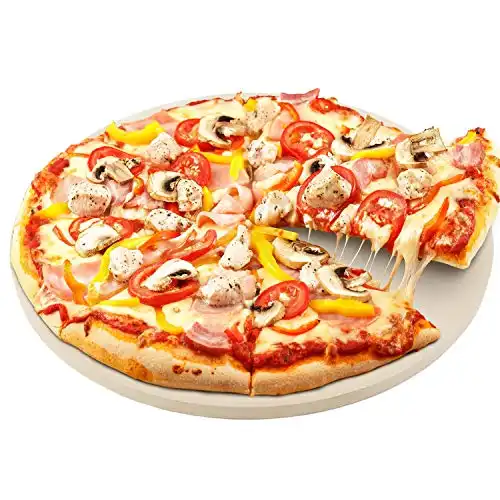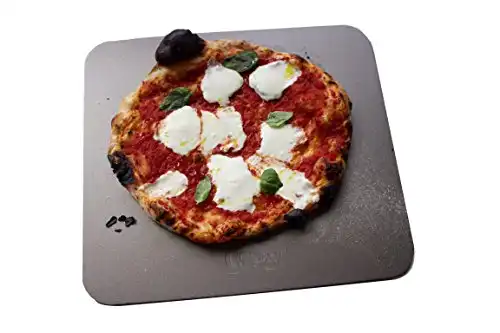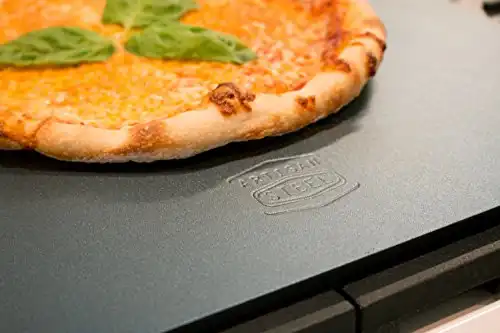Best Pizza Stone for 2024

If you aren’t fortunate enough to have a proper brick wood-fired oven, a pizza stone can help you get a perfect crust on your pie.
The porous stone draws out moisture, so you don’t get a soggy bottom, and, when adequately preheated, it provides an initial burst of constant heat to help the dough puff up.
If you’re looking for a pizza stone but don’t know which one to pick, don’t worry, we’ve done the leg work for you!
What’s the best pizza stone to buy in 2024?
Pizza stones come in a range of materials and finishes. So, to help you find the right stone for you, we’ve reviewed some of the best pizza stones on the market.
1. Best all-rounder – Cast Elegance Thermarite Pizza Stone
We’ve chosen the Cast Elegance Thermarite pizza stone as our best all-rounder because of its performance and durability.
The stone itself is made of Thermarite, a chemically reinforced version of the mineral cordierite, which is famously resistant to sudden temperature changes. This solves the problem of your stone cracking, which is one of the main issues with pizza stones.
The material itself is tested and approved by the FDA and the European Union Food Standards Commission.
Thermarite also has a series of micropores in the material that helps to absorb excess moisture.
Cast Elegance’s stone is 16-inches in diameter and ⅝ of an inch thick. This makes it a little large for most conventional ovens. On the flip side, it will fit in most pizza ovens and is designed to fit on top of a BBQ grill, where the Thermarite’s heat resistance will prevent the bottom of your pizza from charring.
What we like:
- Crack-resistant – The Thermarite construction means you can put a frozen pizza directly on the preheated stone, and it won’t crack under the stress.
- BBQ friendly – Thermarite is sufficiently heat resistant that you use it for cooking pizza over an open flame.
- Micro-pores – The porous nature of the material helps to wick excess moisture from the base of your pizza.
What we don’t like:
- Not oven friendly – The 16-inch diameter means this stone isn’t going to fit into most conventional ovens.
2. Most Versatile – Tuida Ceramic Pizza Stone
The Tuida Ceramic pizza stone is designed to give you as much bang for your buck as possible. The 13-inch diameter means it can be used on most conventional ovens without an issue. It’s also specifically designed to work on a grill or BBQ.
Because it is made of ceramic, this stone needs to be heated slowly to avoid cracking. However, once it’s up to heat, the ceramic surface will provide the excellent heat distribution and the high heat retention that you need to ensure you get a perfectly crisp base.
That heat distribution and retention also allows you to cook a broader range of food on this stone, from bread to delicate crepes.
Ceramic stones do need to be seasoned before initial use. Make sure you apply several thin coats of oil and heat the stone at around 350-400℉ for an hour before you use it for the first time.
What we like:
- Versatile – This stone can be used with a variety of cooking equipment and can cook a range of food – not just pizza.
- Excellent heat distribution – The ceramic material this stone is made of both retains and distributes heat uniformly.
What we don’t like:
- Needs seasoning – Before you use your stone for the first time, it will need to be seasoned, much as you would with cast iron grill grates.
3. Most durable – California Pizza Stones Square Industrial Stone
Durability is critical when it comes to a pizza stone, as they need to endure some reasonably extreme temperature changes without cracking due to thermal shock.
We’ve added the California Pizza Stones square industrial stone to our list because of its sheer durability.
The stone is made of high-grade Non-Toxic Mullite, which is extremely hard-wearing and resistant to heat shock. Mullite is also porous, so it will draw excess moisture from the base of your pie.
California Pizza Stones are so sure it won’t crack under the pressure that they offer a 100% guarantee against cracking and thermal shock, replacing any faulty stones free of charge.
The stone itself is 16 x 16 x 1 inches and a whopping 16 pounds, so you might struggle to fit it into a smaller conventional oven. However, where this stone really shines in a proper pizza oven, where it can be preheated rapidly and repeatedly used without the need to worry about it shattering under the strain.
What we like:
- Durable – If you’ve had issues with pizza stones cracking before and want something hard-wearing, then this is stone for you.
- Thermal shock guarantee – If your stone does break because of thermal shock, California Pizza Stones will replace it for you.
What we don’t like:
- Unwieldy- At 16 x 16 inches and weighing 16 pounds, this is not a portable item and might not fit in your oven.
4. Best compact stone – Pampered Chef 8.5″ Personal Pizza Toaster
If your oven is on the smaller side, or if you’re only making pizza for one, then you might find a lot of the large stones on this list a little too large for use. That’s where the Pampered Chef Personal Pizza Toaster comes in.
At 8.5 inches in diameter, with a quarter-inch lip, and weighing just 1.75 pounds, the Personal Pizza Toaster will fit into even the smallest conventional oven and is also designed to be used with microwaves or toaster ovens.
As with most stoneware pizza stones, the Personal Pizza Toaster will need to be seasoned before use with a light oil, like peanut oil, and shouldn’t be washed with soap or put in the dishwasher.
What we like:
- Compact – If you’ve only got a mini oven, or even just the toaster oven, the Personal Pizza Toaster is an ideal size.
- Microwave safe – Most of the stones on this list are far too large to be used in the microwave. The Personal Pizza Toaster, however, is specifically designed to work in your microwave.
What we don’t like:
- Small – The Personal Pizza Toaster is excellent at what it does, but if you’re looking to make more than a one-person pizza, this stone is going to come up short.
5. Best budget pick – KXT Cordierite Pizza Stone
If you’re looking for an uncomplicated and straightforward pizza stone, then the KXT Ceramic Pizza Stone is right up your alley.
Made from heavy-duty Cordierite, which is food safe and resistant to thermal shock, this stone comes in three different sizes, 10.25 inches, 12 inches, and 15 inches. This means you can pick the size that suits your oven or BBQ or have a stone for each.
The Cordierite material that makes up the stone can be heated to 1450°F (787℃) to provide the initial burst of heat needed to crisp up your base and puff up your crust.
There aren’t any bells or whistles to this stone, but it is usable, durable, and practical.
What we like:
- Simple – Easy to use and durable; this is a no-nonsense pizza stone.
- High heat tolerance – As with most Cordierite products, this stone is resistant to thermal shock and less likely to crack when exposed to high temperatures.
What we don’t like:
- No square option – The KXT stone comes in several sizes, but it would have been nice to also have a square option for baking.
6. Best premium product – The Baking Steel
The Baking Steel might be pricey, but you really do get what you pay for. Made from high-quality steel, this pizza ‘stone’ stores eighteen times more energy than traditional ceramic pizza stones.
This additional energy storage translates into a rapid burst of heat that ensures your pizza’s base remains crisp and the crust puffs up.
The Baking Steel is a 14-inch x 16-inch x ⅜ inch square and weighs in at a heavyweight 23 lbs. Unlike most pizza stones, the Baking Steel does not need to be seasoned, as it comes pre-seasoned with a proprietary oil. Since it is not porous, it can also be washed with soap and water.
There are multiple sizes and thicknesses on offer, and you can get your Baking Steel in round or square.
One of the main benefits of choosing a steel over a ceramic stone is that it won’t crack due to thermal shock and can be preheated much more rapidly. It also won’t shatter if dropped or knocked.
What we like:
- High quality – The Baking Steel is made from the highest quality steel.
- Durable and shock-resistant – The steel stone can be pre-heated quickly without the risk of shattering and won’t crack due to thermal shock.
What we don’t like:
- Non-porous – One of the downsides of steel is that it is non-porous, so it won’t wick away excess moisture from your pie’s base.
7. Best Steel – Artisan Steel High-Performance Pizza Steel
If you like the idea of a pizza steel instead of a pizza stone, but don’t want to spend out on The Baking Steel, then the Artisan Steel High-Performance Pizza Steel is a great alternative.
Made in the USA from high-quality high-carbon steel, this 16.00 x 14.25 x 0.25-inch pizza steel is excellent at conducting heat into the base of your pie without any of the fragility and thermal shock issues of a pizza stone.
Pizza steels are also a little more multi-function than a stone. You can use them as a griddle on your BBQ, bake bread on them, or even put them in the freezer to use as a base for slab ice cream.
You will need to season your pizza steel before the first use by oiling it and baking at 375°F for one hour. After that, you’ll have a durable and practical cooking surface that will last you for years.
What we like:
- Good quality steel – Made from high-quality steel in the USA.
- Versatile – You can use your steel to make everything from pizza to ice cream.
What we don’t like:
- Single size – It would have been nice to have multiple size options, as with The Baking Steel, for different sized ovens.
Now that we’ve reviewed some of the best stones and steels on the market, we’ll break down everything you need to know as a buyer.
Why should you buy a pizza stone?
Pizza stones perform two essential functions when it comes to cooking a pizza. Firstly, when properly preheated, they provide an initial burst of heat to your pizza dough. This burst of heat ensures that the bottom of your pizza cooks to a nice crisp texture, and the crust puffs up into those iconic Neapolitan-style bubbles.
The second thing a pizza stone does is that it removes some of the excess moisture from the base of your pizza, making it less likely that you’ll have a soggy bottom.
The reality is that regardless of whether you are cooking in your home oven, in a specific pizza oven, or on your BBQ, using a pizza stone is going to give you better results.
When not to use a Pizza stone
If you are cooking on a traditional wood fired pizza oven, the oven floor is all you need.
Some more portable pizza ovens like those produced by Ooni have a pizza stone-baked base.
We have a guide to some of the best outdoor pizza ovens if you want to learn more.
Stone vs. steel – what’s the difference?
While both pizza stones and pizza steels will get you better results when cooking pizza, there are some significant differences between them.
Check out this video for a good overview, or read on to learn the difference between a pizza stone and steel.
Thermal shock
The first significant difference is the issue of thermal shock. In order to be effective, a pizza stone has to reach a very high temperature. If preheated to this high temperature too quickly, the stone can crack.
Once it’s at that high temperature, if the stone is exposed to something at a significantly lower temperature, the thermal stress can cause it to crack.
Some pizza stone materials, such as clay, are more vulnerable to thermal cracking, while others, like Thermarite and cordierite, are more resistant to it.
Pizza steels aren’t vulnerable to thermal shock in the same way as pizza stones. They can be pre-heated more rapidly and won’t crack if errant topping falls on them. Steels are also more durable altogether and won’t shatter when dropped.
Moisture-wicking
One of the benefits of using a stone over a steel is that most pizza stones are made from a porous material.
While this porous nature is what makes them vulnerable to thermal shock, it also means that they can wick excess moisture away from the bottom of your pizza, preventing you from getting a soggy base.
Steel isn’t a porous material, so it doesn’t have this same benefit. However, steel does conduct heat better than most other materials, which offsets its non-porous nature to an extent.
Overall, pizza steels work best for those buyers looking for something durable and hard wearing that doesn’t take too long to heat up, while pizza stones are great if you are trying to avoid the dreaded soggy bottom.
How to choose the right pizza stone for you
When it comes to choosing the right pizza stone for you, there are a few key considerations to take into account:
Size and shape
Obviously, you’ll need a stone or steel that fits into your oven or onto your grill. A fair number of pizza stones or steels are designed to fit into a wider pizza oven, so it’s always worth measuring your oven before buying to make sure your new stone is going to work.
That being said, there are stones on our list above that are specifically designed for home ovens, BBQs, microwave ovens, and toaster ovens, so you’re sure to find one that fits your setup.
Thickness
The thickness of the pizza stone you’re going to buy is also going to depend on your cooking arrangement. For a conventional home oven, you’ll want a thinner pizza stone as your oven won’t get as hot or heat up as rapidly as a BBQ or a pizza oven.
Because of steel’s better heat transference, getting a pizza steel for use in a home oven is usually a better choice than a stone.
For a BBQ, you’re going to want a slightly thicker stone to prevent the intense heat coming up from the gas or coal from charring your pizza.
The thickest stones and steels work best in a proper pizza oven. Pizza ovens get ferociously hot and heat up very quickly, so you’ll be able to properly preheat a thicker stone or steel in a way that a conventional oven can’t.
Rough or smooth?
Generally, pizza stones come with a rough side and a smooth side. While some pizza chefs suggest cooking on the rough side for better moisture control, the evidence for this is mostly anecdotal.
What is well known is that pizza dough sticks to things like glue. When in doubt, use the smooth side of your stone, or buy one with a smooth surface, and dust it with a small amount of semolina flour before cooking.
The smooth surface will cut down on adhesions while the semolina flour acts as a dry lubricant and doesn’t burn as readily as plain flour.
Wrapping it up
Getting yourself a pizza stone is going to improve the quality of the pies you’re cooking, be that in your home oven, on the grill, or in your fancy pizza oven.
Now you’ve read our guide, you’ve got all the information you need to go out and get the right pizza stone for you and start churning out some world-class pizza!
Do you have any great advice on using a pizza stone, or are you currently using a stone you think should have made our list? We’d love to hear from you in the comments section below!

